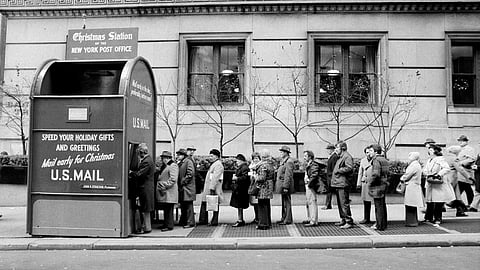

By JENNIFER HARLAN
NEW YORK: As long as people have been buying gifts for the holidays, they have been buying books. Books offer infinite variety, are easily wrapped, can be personalized for the recipient and displayed as a signifier of one’s own identity.
They are, in many respects, the quintessential Christmas — or Hanukkah or Kwanzaa or other December celebration — gift.
This has held true since the very beginning of Christmas as we know it today — a domestic holiday typically celebrated indoors, with family, that prominently features the exchange of presents. “They come in greater numbers every day,” The New York Times reported of the increasingly crowded shops in 1895. “The people who are buying books, the people who are thinking of buying books, and the people who are wondering if there is anything more satisfactory in the world of Christmas delights.”
In fact, this phenomenon can be traced back even further, to the holiday’s more raucous roots. The Yuletide season has been one of celebration since long before there was a Yule to celebrate.
In early agricultural societies, the end of the harvest offered a brief window with an abundance of fresh produce and meat, and not much work to do.
In this topsy-turvy season, the normal rules of society were relaxed, and generosity — particularly on the part of the most fortunate — was encouraged. These festivities have gone by many names; in ancient Rome, it was Saturnalia. And from those earliest days, when people gave, they gave — in their own way — books.
In a collection of “Epigrams,” the first-century poet Martial published a (very extensive) list of suggestions for “The Presents Made to Guests at Feasts.”
“This is before the book as we know it exists,” said Leah Henrickson, a lecturer in digital media at the University of Leeds. And yet among the togas and lyres on this Saturnalian gift guide are several texts on parchment, from Virgil and Cicero to Ovid’s “Metamorphoses.”
The Christian church co-opted Saturnalia when, in the fourth century, it began promoting Christmas, explained Stephen Nissenbaum, an emeritus professor at the University of Massachusetts Amherst and the author of “The Battle for Christmas: A Social and Cultural History of Our Most Cherished Holiday.” Even after the pagan rituals were transformed into a late-December religious rite, gifts continued to figure into the holiday, largely as tokens bestowed by nobles upon peasants — often finer food or drink normally reserved for the wealthy — rather than presents exchanged among family members.
For centuries, Christmas maintained the bacchanalian spirit of its predecessors. The holiday was so debaucherous that the Puritans tried to suppress it: From 1659 to 1681, celebrating Christmas in Massachusetts was illegal. But in the early 19th century, things began to shift. “Christmas moves indoors,” Nissenbaum said. “That’s when it starts to become the family holiday we recognize. And it is transformed from this season of misrule into a domestic holiday not by the church, but by capitalism.”
Wealthy merchants had grown tired of dealing with the marauding bands of revelers who paraded through the city — banging pans, smashing windows and generally causing a ruckus that was not good for business — and they embarked on a campaign of rebranding Christmas as a domestic celebration.
A key component: the invention of modern-day Santa Claus, in large part via Clement Clarke Moore’s 1823 poem “A Visit From St. Nicholas,” also known as “The Night Before Christmas.”
Visit news.dtnext.in to explore our interactive epaper!
Download the DT Next app for more exciting features!
Click here for iOS
Click here for Android